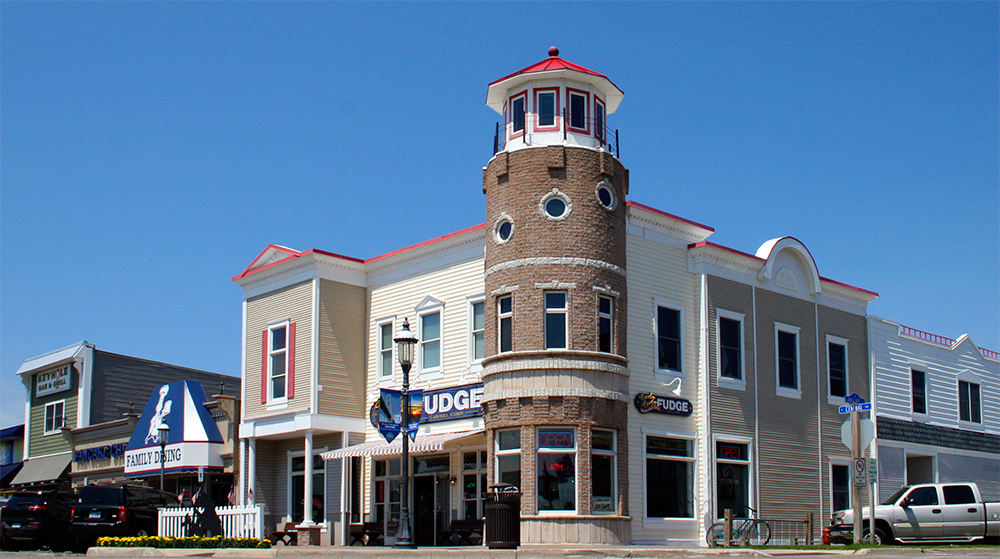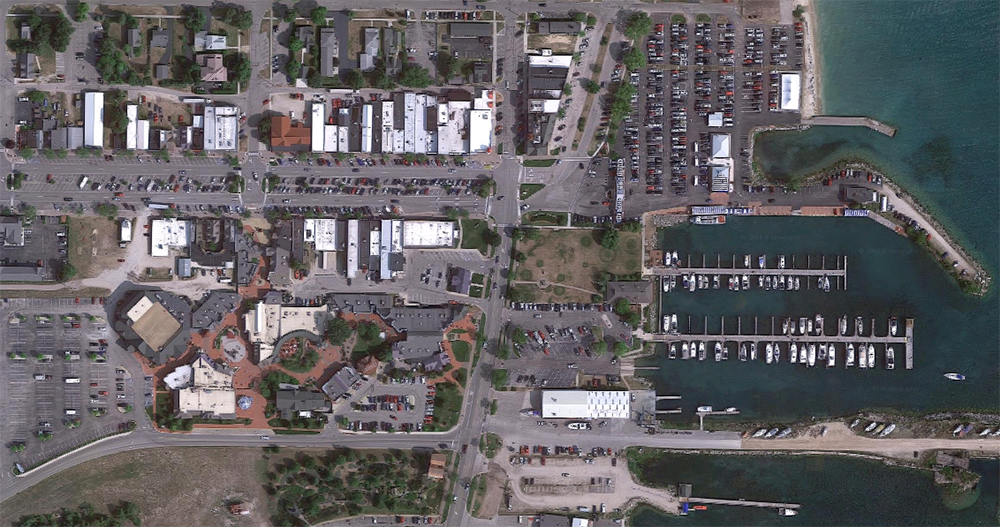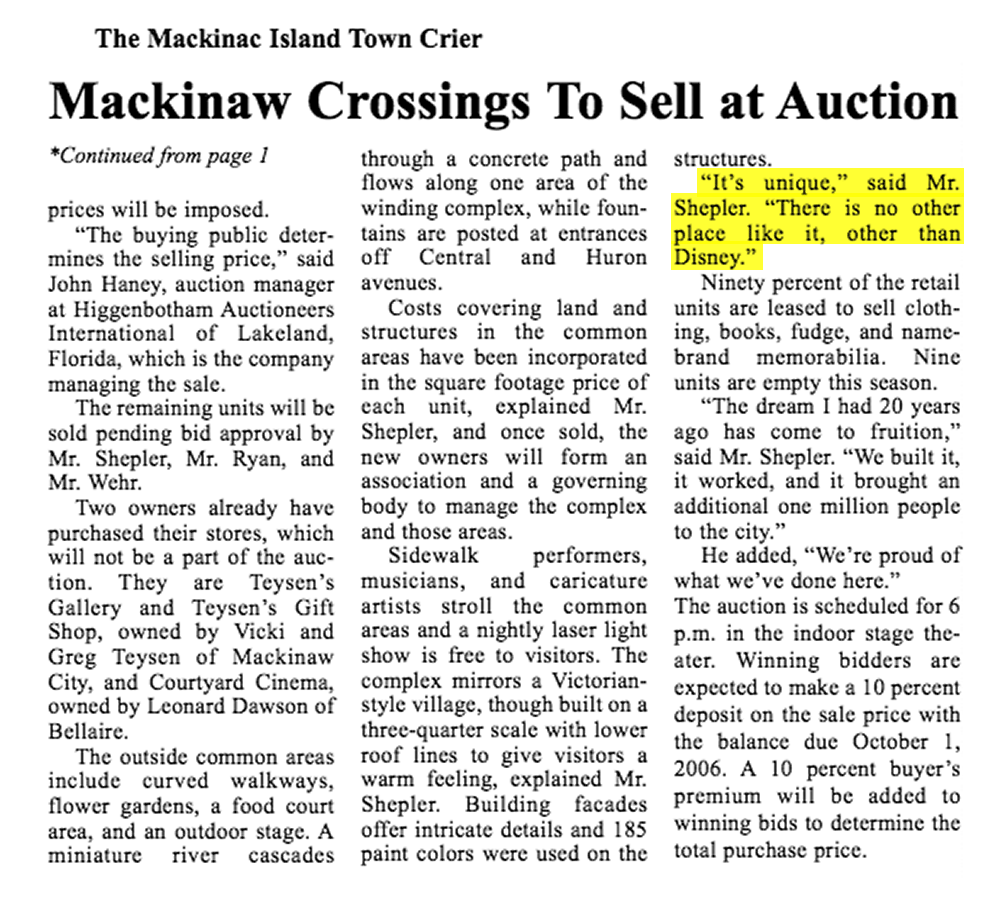Anytown, Europe.
The last stop on the first leg of my summer 2017 road trip was the themed “Alpine Village” town of Frankenmuth, Michigan. Again it was at the suggestion of my travel companion David Janssen Jr. who (rightly) declared it as something I had to see.
Frankenmuth—known as the “Little Bavaria” of the region—is a tourist destination of less than 10,000 people nestled along the Cass River about ninety miles northwest of Detroit.
Vintage postcard of Alpine Village, Torrance, California.
The Alpine Village Model
European themed “villages” like Frankenmuth are common throughout many parts of the United States, and much of their thematic design dates to after the opening of Disneyland. Southern California’s Alpine Village, for example, opened in 1968.
Vintage postcard of Solvang, California.
When I was growing up my family often visited Solvang in the wine country of the Santa Ynez Valley in Santa Barbara County. Solvang has a Danish theme and, like many such towns, was actually founded as a community of settlers from a particular part of Europe, but by mid-century had begun to embrace an enhanced, Disneyland-like form of design to further attract tourists. In 1958, Paul Kuelgen, a scenic artist at RKO Studios, was commissioned to construct stylized gables and dormers on buildings downtown, and when done commented—quite satisfied—that Solvang now “looked like a movie set.”
Vintage postcard of Leavenworth, Washington.
Another such famous town is Leavenworth, Washington which adapted a Bavarian theme in the early 1960s as part of a larger economic revitalization plan. Planners for this project actually travelled to Solvang, California for inspiration. In his history masters thesis The Origins of the Recreational Theme Town in the West (University of Idaho, 1996), Jake Sudderth notes that Solvang was the prototypical model for the “Alpine Village” themed town, utilizing what he calls “contrived architecture.”
In this way, many such towns developed “traditional” brand identities like any other product or company or service. Frankenmuth is very loud and proud about this—the banners above, complete with a (R) registered trademark—are hanging from every street lamp. It’s certainly not subtle and it’s not in any way clever; as a result it’s fairly off-putting.
Frankenmuth is the kind of place where the public trash cans thank you personally—in German.
Historian Richard V. Francaviglia suggests that this move towards regionalization was indeed a marketing tactic, and a way for communities to survive (and perhaps even thrive) as out of the way, off-the-beaten-path tourist stops. Again from his Main Street Revisited:
There are signs that Main Street design reflects a need to recognize diversity in the face of overwhelming assimilation. This has been become apparent in the late twentieth century, when regional or ethnic identity is marketed by communities. On Main Street, the search for regional identity has taken on a touch of the fanciful or bizarre as certain towns have deliberately attempted to create townscapes that recapture the original ethnic heritage of their residents.
The “Alpine Village” look of the Matterhorn Bobsleds at Disneyland, 2008.
The original concept art for Disneyland featured highly detailed and stylized European theming, a true ‘village’ look surrounding the courtyard of Sleeping Beauty’s Castle. However, the project ran out of funding in the long march to opening day, and Walt Disney had to settle for a “Medieval Royal Pageantry” look of tents, festive flags, and shields which barely disguised the steel sheds containing the land’s dark ride attractions.
A year after Disneyland opened, Walt got his wish for an “Alpine Village” theme with the addition of the park’s Skyway attraction; aerial tram buckets departed from a traditional chalet-style building. And in 1959, the Matterhorn Bobsleds debuted, featuring a queue building straight out of the Swiss Alps.
The 1983 redesign of Fantasyland at Disneyland, 2008.
In the early 1980s, Fantasyland was largely demolished, and the former festival sheds were replaced with a highly realized European village which was a much better fit for both the Matterhorn and Sleeping Beauty’s Castle. In this sense, the “Alpine Village” had come full circle, returning to the park which spawned the popular look of towns like Frankenmuth.
Vintage postcard of Sugarcreek, Ohio.
As Francaviglia points out, a great many towns in the Midwest embraced an Alpine theme in the wake of Disneyland’s enormous success. He notes that “merchants in Sugarcreek, Ohio, added Alpine motifs, including detailed porches, balconies, and gables to their Main Street to achieve a Swiss theme; some communities in Minnesota perpetuate their Finnish and German ethnic heritage through themed architecture on Main Street.”
It’s clearly the influence of Disney, as “this type of themed remodelling as been taking place since the 1950s and 60s.” Francaviglia could easily have been talking about Frankenmuth; note the resemblance here.
Very much like the Old West, the “Alpine Village” theme is often expressed liberally and abundantly through typography. The average American tourist is unlikely to be able to identify the various European regional forms of Blackletter script (Textura, Schwabacher, Fraktur, Cursiva, Hybrida/Bastarda etc.), so anything appearing to be “calligraphy” fits the bill. Again, Disney certainly popularized these uses throughout the twentieth century.
Sometimes this lettering is painted, but often it’s cut out of wood as well. Frankenmuth is also the kind of town where you’ll find a Haus instead of a House.
Generic Blackletter lettering is also rendered in 1950s–style neon, as here on the marquee for the very locally famous Zehnder's chicken dinner restaurant.
Vintage postcard of Zehnder’s.
The original property dates back to the decade before the Civil War, was remodeled in the 1920s, and took off in its current incarnation after World War II. During the late 1950s, the family-owned Zehnder’s company started buying other properties around town. Curiously, the current restaurant looks very much like this postcard from the 1940s—no attempt has been made to retheme it, and it retains this sort of New England colonial flavor.
The Bavarian Inn Restaurant
“Strong regional identities persist, if not as an authentic part of their character then as almost theatrical sets,” notes Francaviglia. This theatricality—this thematic design—is perhaps best executed at the Bavarian Inn Restaurant.
Vintage postcard of Fischer's Hotel.
Originally Fischer's Hotel, Zehnder’s bought the property as part of its post-war expansion in Frankenmuth. In 1959, it was renamed and rethemed in a very Disney-esque style.
Although the town is popularly known as “Little Bavaria,” the architectural details featuring X’s and diamonds on the buildings in Frankenmuth are actually Franconian.
The signage resembles the original Fantasyland voice of the Disney parks—circa 1950s, given the casual advertising style of brush script type. If this sign has been redone since Kennedy was in office, I can’t tell.
The complex is far larger than it appears from the exterior—three levels of shopping and dining.
From the side alley, the illusion is clear; the castle-like structure which faces the primary thoroughfare (South Main Street) hides the true depth of the building—again, a trick borrowed from Disney’s designers.
The castle tower out front is also designed with forced perspective, making it seem far taller than it actually is. Of course, in Frankenmuth medieval architecture like this isn’t authentic in any historical sense, but it adds a touch of Disney-esque fairytale fantasy—despite the American flags fluttering in the breeze above the ramparts.
Another trick borrowed from Disney is having a single structure appear to be different things from different angles. Looking south from Main Street, the castle is dominant. Looking north, it’s more of a haus presentation later in history.
The entire complex appears to slowly morph along Main Street, becoming more domestic and rustic, less regal and imperial.
To the south side of the Bavarian Inn is another massive facade featuring a decorative clock based on the The Rathaus-Glockenspiel of Munich which performs on a regular schedule.
After eating at one of the Inn’s German restaurants, we strolled the Holz Brücke (German for “Wooden Bridge,” as the sign indicates), a 239 foot, 230 ton covered span across the Cass River traditionally designed to look like it was built in the 1870s, but was of course actually erected in the 1970s.
Apparently folks walk the bridge, and then they walk back.
The Bavarian Inn Lodge
The Holz Brücke also is drivable over to the Bavarian Inn Lodge on the other side of the river, which is—you guessed it—owned by the family company behind Zehnder’s.
Again Frankenmuth demonstrates design cleverness at subverting scale (and thus expectations). From above you can see how extensive the complex actually is.
The Bavarian Inn Lodge was part of a 1985–86 resort expansion in Frankenmuth, and it shows. While the theming has more of a master plan approach, a bunch of Las Vegas (ala Vail) components hang off the lodge like these waterslides—giving the whole thing something of a silly Willy Wonka vibe.
The hotel entrance is clearly designed to harmonize with the original, late 1950s Bavarian Inn on the other side of the Cass River.
Part of the newer, Walt Disney World-style theming that is not evident in midcentury Frankenmuth is the concept of constructing a single large facility which appears, outwardly, to be a natural conglomeration of smaller local businesses.
In Europe, you’d likely be paying an actual small-time proprietor named “Oma,” but here the cash registers all ring for the owners of the Bavarian Inn Lodge—Zehnder’s.
The Bavarian Belle Riverboat
After walking across the Holz Brücke, we bought our tickets to take a cruise down the Cass River on the Bavarian Belle Riverboat, a fully restored 150-passenger paddlewheeler.
It was neat to go on a “ride” which added a theme park element to the town experience—very much like the Mark Twain Riverboat at Disneyland.
The River Place Shops
The newest thematic addition to Frankenmuth are the Frankenmuth River Place Shops which were built in 2001 and are dripping with late 90s theming. The website proudly proclaims “OVER 40 SHOPS AND ATTRACTIONS” and invites you to “SPEND THE DAY AT FRANKENMUTH’S VERY OWN GERMAN THEMED OUTDOOR SHOPPING MALL.” I thought it curious that the term ‘German Themed’ was emphasized.
The shops are a stand-alone, integrated complex along Main Street on the south edge of the Cass River. The Bavarian Belle Riverboat can be seen docked at the right.
Map of the River Place Shops.
I was struck by the strong likeness to the Mackinaw Crossings retail district which I had recently visited on this same trip; they could have been designed by the same company by all appearances.
The architecture—as typical of these types of outdoor malls—is an eclectic mix, in this case, of “European-ness.” Not just German but also French, Dutch, and Scandinavian forms are evident.
Some of the shops are a very drastic departure from the Bavarian/Franconian theming which was introduced to Frankenmuth at midcentury.
Also typical of themed developments from this era are cost-cutting measures that impact the immersive qualities of the design—here most distinct in the windows, which could be from any late 90s McMansion track housing neighborhood. The painting schemes are also more garish and less carefully considered than you’d find at a Disney park; this is Disney on the cheap.
One of the hallmarks of late 1990s to early 2000s thematic design is the indoor painted sky. You can see this kind of treatment everywhere from Las Vegas casinos to Dubai shopping malls. I think Disney realizes how tacky this looks—they’ve only ever attempted “indoor for outdoor” in a nighttime setting, which can be quite stunning. Painted white clouds on powder blue just look cheap, like a children’s hospital daycare center.
I have a different appreciation for these kinds of spaces, a kind of ironic appreciation, like a guilty pleasure. Late 1990s to early 2000s theming—shopping malls, but also dining and casinos—is the b-movie equivalent of thematic design. I kind of love it because it’s so shabbily executed, because it’s so cheesy. The architecture is clearly planned and built to be appropriately referential, but the environmental immersion falls apart in poor materials choice, slapdash color, and an overall lack of detailing. All negatively impact verisimilitude.
Like many layered cakes I’ve seen on this journey, Frankenmuth is surprisingly complex, with multiple eras of theming, redesigns grafted onto authentic history, and fabricated history. From the late 1950s, Disneyland-inspired Bavarian Inn Restaurant (“Fake Real”) to the late 1990s Las Vegas casino-esque Frankenmuth River Place Shops (“Real Fake”), this classic Midwestern “Alpine Village” has it all. Even signs in German that bid you farewell.













